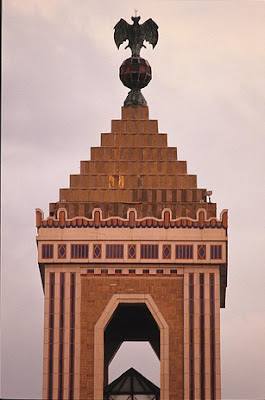The second thing to notice is the design. The structure is the largest of Wright's Los Angeles-based “textile block designs” i.e using thousands of interlocking, pre-cast and patterned concrete blocks. Concrete was still a new material for home construction in the 1920s, so Wright’s materials were certainly cutting edge. But more than that. The detail that immediately stands out is the relief ornamentation on its concrete blocks, inspired by the symmetrical reliefs of ancient Mayan temples.
Ennis House exterior, with amazing views
Architectural Digest (October, 1979) agreed, saying: "The Ennis House is one of the first residences constructed from concrete block. Wright transforms cold industrial concrete to a warm decorative material used as a frame for interior features like windows and fireplaces as well as columns. His 16” modular blocks with intriguing geometric repeats invite tactile exploration. The art glass windows and doors, reminiscent of examples from the earlier prairie period, here achieve greater colour suddenly as they graduate in intensity from darker at the top to lighter at the bottom. The metal work based on Mayan imagery is not of Wright's design, and may have been included at Mr Ennis' request. Yet from the very large iron grill at the main entrance to such minute details as light switches and lock plates, there is a unity of conception and materials that complements the entire structure."
I wonder why the house was designed by Frank Lloyd Wright, but built and supervised by his son, Lloyd Wright. And I wonder why the early, horizontal Prairie Style was not utilised here. Because California was substantially different, in climate or in taste, from Chicago? Was the Prairie Style too arts & craftsy, and too early C20th for the sophisticated 1920s? It seems that Wright felt typecast as the Prairie house architect so he used the Los Angeles era to broaden his architectural vision.
In any case Mr Ennis was a passionate scholar of Mayan art and architecture, even before he had discussions with the architect.
The house had 2 buildings, the main house and a staff flat, separated by a paved courtyard. Unlike the vertical orientation of the other three textile block houses, the Ennis House has a long horizontal loggia spine on the northern side connecting public and private rooms to the south.
living room, then steps up to the dining room
There had been structural problems with the Ennis House since the beginning; the concrete blocks had cracked and the lower sections of the walls had moved. The concrete was a combination of gravel, granite and sand from the site, mixed with water and then hand-cast in aluminium moulds to create the blocks. It took 10 days for each block to dry before it could be stacked into position. Perhaps using decomposed granite from the site, to colour the textile blocks, introduced impurities to the concrete mix. And combined with Los Angeles’ specific air pollution problems, perhaps this had caused the concrete to moulder.
Nonetheless Wright firmly believed concrete held potential as a material for affordable housing.
More damage occurred due to the 1994 Northridge earthquake and the record rain in 2004-2005. The Ennis House Foundation was very worried about the millions of dollars it would take for the full restoration project.
In 2005 the house was added to the National Trust for Historic Preservation's list of the Most Endangered Historic Places. In 2006 a Federal Emergency Management Agency grant was issued and the restoration work went ahead. The house has since been declared a Los Angeles Historic-Cultural Monument.
dining room
More recently, Frank Lloyd Wright's La Miniatura/Millard House (1923) in Pasadena has come up for sale. For amazing photos of the patterned concrete blocks inside and out, see the Glamour Drops and Rich of Eve blogs. The Millard House is listed on the USA's National Register of Historic Places.





































































.jpg)















